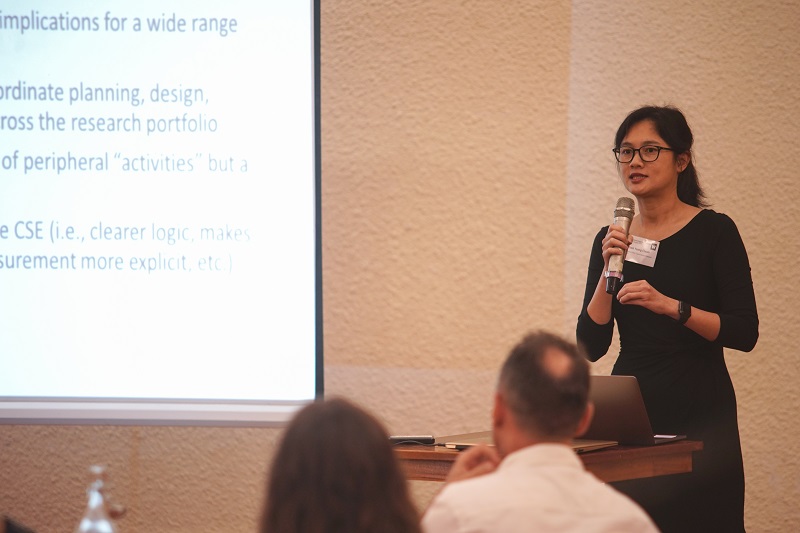Phaik Yeong Cheah, the Head of Bioethics and Engagement at the Wellcome Africa and Asia Programme (AAP), Mahidol Oxford Tropical Medicine Research Unit (MORU) in Thailand, presented on the process of developing MORU’s community and public engagement (CPE) strategy to the attendees of the 2018 Wellcome International Engagement Workshop. She discussed the aims of a strategy, the value to community and public engagement professionals of working strategically, and how they are going about creating their strategy at MORU.
Image: Phaik Yeong Cheah presenting at the Wellcome International Engagement Workshop | Minh Tan
What is “Strategy”?
Phaik Yeong highlighted the history of the term ‘strategy’. Coming from Greek, it is historically a military term, and in military and business settings generally refers to a plan of action for how to ‘win’. But in the context of health research and community engagement, there is no simple ‘win’; the logic of a CPE strategy will always be more complex, in particular because of the wide range of different interests affected by the conduct or outcomes of any research program. Phaik Yeong argues that CPE is about helping research programs achieve their scientific objectives, while acknowledging and safeguarding the interests of stakeholders.
The Need for Strategy
The MORU team wanted community and stakeholder engagement to be more fully integrated into the organisation’s planning and management processes for its research programmes. MORU’s research programmes involve multiple stakeholders, institutions and communities across all of South Asia and parts of Africa, and a wide range of ethical and practical challenges. Having engagement embedded across the work of the whole organisation will help the Unit coordinate its research, which will provide critical new insights about how CPE works in research programs and what value it can deliver for these programmes and for stakeholders, alike. To prepare to implement the new CPE strategy, the engagement team is mapping what engagement is happening already, what activities would fit each research area, and how to gain buy-in from MORU senior leadership.
Developing a Strategy
The MORU strategy is only part-way through its development. To begin building a strategy in this complex environment they have used a model created by the Human Engagement Learning Platform (HELP) for Global Health. This model states that a strategy needs:
- Conceptual foundations: what are the key concepts and aims of the strategy, and what are their implications for its design, management and outcomes?
- Ethical foundations: what are the ethical goals and commitments of the strategy, and their implications for its design, management and outcomes?
- Planning: what are the implications of the science program for stakeholders? What budget and enabling conditions are in place to ensure effective CPE? What types of authorisation will be required for the various research programmes and what CPE will be required to support these?
- Design: how do the specific features of the research programmes and the contexts in which they are conducted inform and/or constrain the design of the CPE strategy?
- Management: how will leadership, human resources, and stakeholder relationship management be taken on? How will the CPE strategy be integrated into the research program?
---
The content on this page forms part of the online report for the 2018 International Engagement Workshop “Taking it to the Next Level: How can we generate leadership and develop practice in engagement?". To learn more about the workshop, access the rest of the report and browse the video presentations, discussion summaries, and tools, visit the workshop page.

This work is licensed under a Creative Commons Attribution 4.0 International License.


Please Sign in (or Register) to view further.